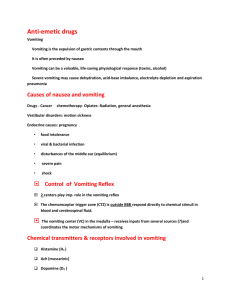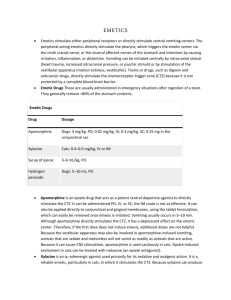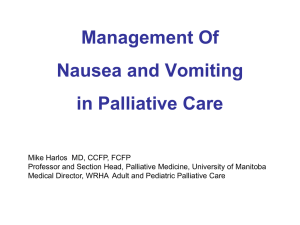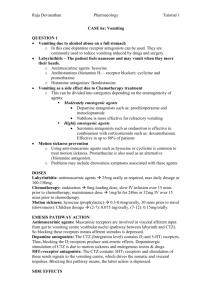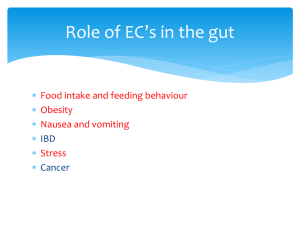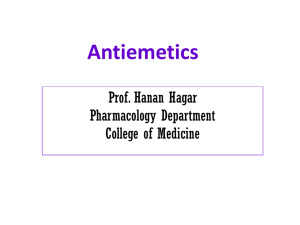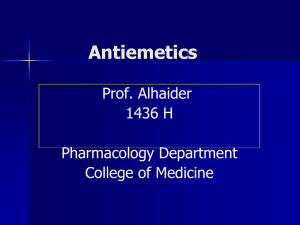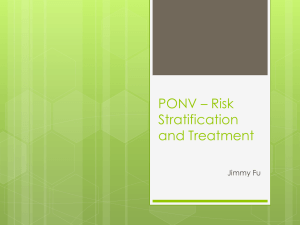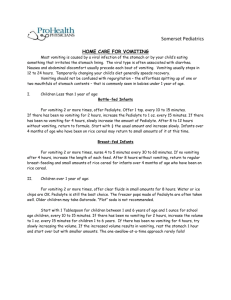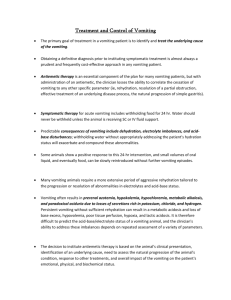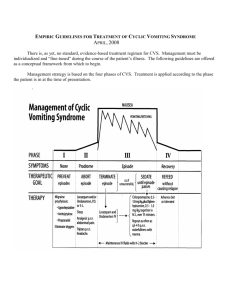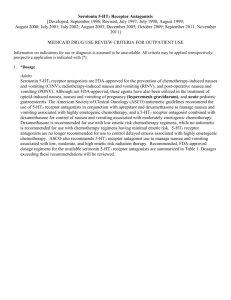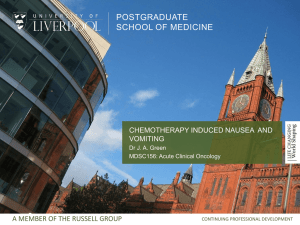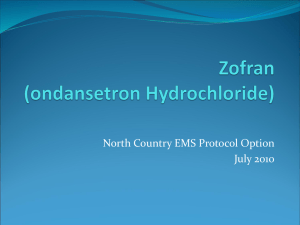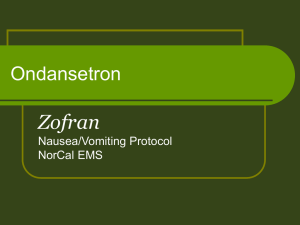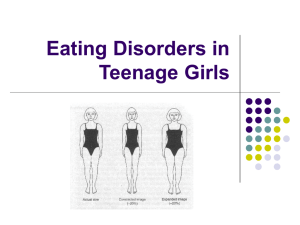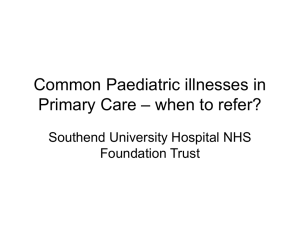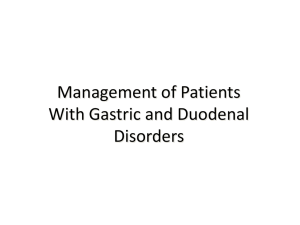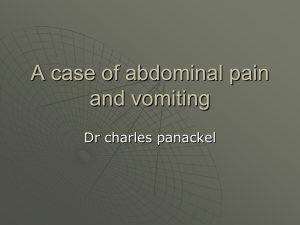CTZ - Dundee MBChB
advertisement
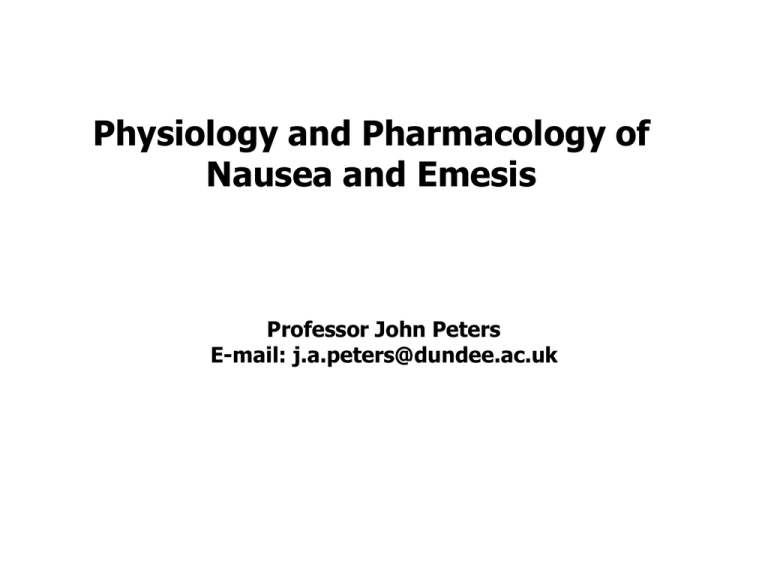
Physiology and Pharmacology of Nausea and Emesis Professor John Peters E-mail: j.a.peters@dundee.ac.uk Learning Objectives Following this lecture, students should be able to: Provide a brief description of nausea Describe the key events in vomiting List the major consequences of severe vomiting Describe the various triggers for vomiting Be aware of the role of the chemoreceptor trigger zone (CTZ) and vomiting centre (VC) in vomiting Know the major classes of antiemetic drugs, their clinical uses and be able to outline their proposed mechanisms of action • 5-HT3 receptor antagonists • Muscarinic receptor antagonists • Dopamine receptor antagonists • Cannabinoids Events in Vomiting Vomiting (emesis) forceful propulsion of gastric contents out of the mouth Is not due to stomach contraction – stomach, oesophagus and associated sphincters are relaxed Vomiting is co-ordinated by the vomiting centre (VC) in the medulla oblogata of the brain stem Deep inhalation Repeats of the cycle Closure of glottis and raising of soft palate Ejection of gastric contents Suspension of breathing Contraction of diaphragm and abdominal muscles compresses stomach Vomiting is frequently preceded by profuse salivation, sweating, elevated heart rate and the sensation of nausea Nausea Subjective, highly unpleasant, sensation – normally felt in throat and stomach as a ‘sinking’ sensation Acute nausea interferes with mental and physical activity, often relieved by vomiting Chronic nausea is greatly debilitating Nausea usually involves pallor, sweating and relaxation of the stomach and lower eosophagus resulting in tension in gastric and oesosphageal muscles triggering afferent nerve impulses: associated events are Contraction of upper small intestine, followed by contraction of pyloric sphincter and pyloric region of stomach Movement of contents of upper jejunum, duodenum and pyloric region into the body and fundus of the stomach Relaxed lower and upper eosophageal sphincters and oesophagus set the stage for retching and vomiting (which may, or may not, occur) Consequences of Severe Vomiting Dehydration Loss of gastric protons and chloride (causes hypochloreamic metabolic alkalosis, raising of blood pH) Hypokalaemia. Mediated by the kidney, proton loss is accompanied by potassium excretion Rarely, loss of duodenal bicarbonate may cause metabolic acidosis Rarely, eosophageal damage (Mallory-Weiss tear) Triggers for Vomiting Pain, repulsive sights, smells and emotional factors CTZ Motion sickness and vestibular disorders Endogenous toxins, numerous drugs, radiation VC Medulla Stimuli from pharynx, G.I. tract and other viscera Pregnancy Output to vagus nerve and spinal motor neurones Intracranial pathology VC = Vomiting centre CTZ = Chemoreceptor trigger zone (located in the area postrema, detects circulating emetic agents e.g. toxins, opiates, apomorphine) Triggers for Vomiting Pain, repulsive sights, smells, emotional factors Motion (inner ear), signalling to vestibular nucleus Pharyngeal stimulation, gastric/duodenal distension, or irritation NTS CTZ Retching, vomiting VC NTS = nucleus tractus solitarius Endogenous toxins, drugs, vagal afferents Lacks blood brain barrier (BBB) Drug- and Radiation-Induced Emesis Many classes of drug (or treatments) predictably cause nausea and vomiting Cancer chemotherapy and radiotherapy (release of 5-HT from enterochromaffin cells in the gut) Operations involving the administration of a general anaesthetic [postoperative nausea and vomiting (PONV)] Agents with dopamine agonist properties (e.g. used in Parkinson’s disease). Dopamine D2 receptors are prevalent in the CTZ Morphine and other opiate analgesics (tolerance develops) Cardiac glycosides (e.g. digoxin) Drugs enhancing 5-HT function (5-HT3 receptors are prevalent in the CTZ) Major Classes of Antiemetic Drugs 5-HT3 receptor antagonists (e.g. ondansetron) Used to suppress chemotherapy- and radiation-induced emesis and post-operative nausea and vomiting Block peripheral and central 5-HT3 receptors Cytotoxic drug Circulating, or locally released 5-HT Peripheral terminal in gut 5-HT Vagal afferent Central terminal AP (containing CTZ) and NTS Vomiting centre Radiation = 5-HT3 receptor AP = area postrema; NTS = nucleus tractus solitarius Emesis Reduce acute nausea, retching and vomiting in cancer patients receiving emetogenic treatments (day 1) Less effective during subsequent treatments (delayed phase) – improved by the addition of a corticosteroid (mechanism uncertain) Not effective against motion sickness, or vomiting induced by agents increasing dopaminergic transmission Generally well tolerated – most common unwanted effects are constipation and headaches Muscarinic acetylcholine receptor antagonists (e.g. hyosine /scopolamine) Used for prophylaxis and treatment of motion sickness (can be delivered by transdermal patch) Probably block muscarinic acetylcholine receptors at multiple sites (e.g. vestibular nuclei, nucleus of the solitary tract, vomiting centre) Direct inhibition of G.I. movements and relaxation of the G.I. tract may contribute (modestly) to anti-emetic effects Have numerous unwanted effects resulting from blockade of the parasympathetic ANS (e.g. blurred vision, urinary retention, dry mouth) and centrally-mediated sedation Histamine H1 receptor antagonists (e.g. cyclizine + many others) N.b. many agents in this class also exert significant blockade of muscarinic receptors that probably contributes to their activity Used for prophylaxis and treatment of motion sickness and acute labyrinthitis Action attributed to blockade of H1 receptors in vestibular nuclei, nucleus of the solitary tract and area postrema Generally cause CNS depression and sedation – drowsiness may affect performance of skilled tasks Dopamine receptor antagonists (e.g. domperidone and metoclopramide) Used for drug-induced vomiting (e.g. cancer chemotherapy, treatment of Parkinson’s disease with agents stimulating dopaminergic transmission) and vomiting in gastrointestinal disorders. Use in children is restricted – consult BNF Complex mechanism of action •Centrally block dopamine D2 receptors in the CTZ •Peripherally exert a prokinetic action on the oesophagus, stomach and intestine Domperidone does not cross the blood brain barrier and is less likely to result in the many unwanted effects of metoclopramide (e.g. disorders of movement (extrapyramidal effects)) Not effective against motion sickness Phenothiazines – which owe part of their action to dopamine D2 blockade – are used for severe nausea and vomiting Cannabinoids (e.g. nabilone) Used ideally in in-patient setting for treatment of cytotoxic chemotherapy that is unresponsive to other anti-emetics Decreases vomiting induced by agents stimulating the CTZ. Evidence suggests that opiate receptors are involved in drug effect Numerous unwanted effects; drowsiness, dizziness, dry mouth, mood changes are common
